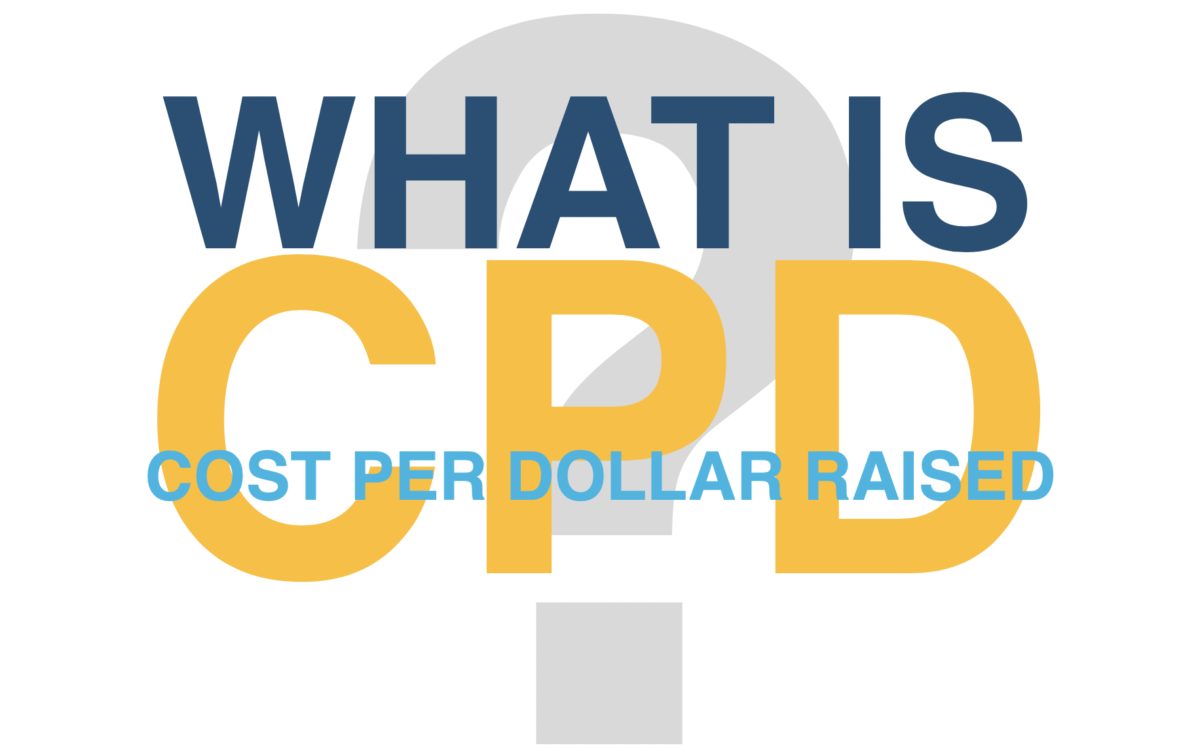Cost per dollar raised, or CPDR, is not discussed as often as donor acquisition cost or donor retention. Rather, this somewhat underrated metric is tied carefully to both. Staying on top of CPDR is critical to understanding the donations made to your organization and what they mean.
CPDR is a fairly straightforward term – it simply refers to the amount of money it takes your organization to raise one dollar.
Calculating CPDR
When calculating the cost for each dollar, all you have to do is divide the total amount of money spent during a given business period (year, quarter, etc.) by the amount of money made during that same period. More formally, just divide costs by earnings.
For example, let’s say your charity made $20 one year in donations. To make that money, your organization spends $5 in ad costs, wages, and all other expenses. You’d complete the formula this way:
Cost ÷ Earnings = CPDR, therefore 5 ÷ 20 = .25
Hence, each dollar cost 25 cents to raise, and your CPDR is $0.25.
This calculation is rather simple, but it’s really just the end calculation that should be made after many other metrics are evaluated. CPDR is a loaded topic but can be easily broken down into a few different expenditure components. Let’s go over some of those now.
Breaking it Down
First thing’s first – staying on top of cost per dollar raised means staying on top of your metrics. The key to optimizing CPDR is making sure that you understand your organization and your donation patterns as thoroughly as possible. This way, you can determine new strategies to obtain more donation money (and therefore lower your CPDR).
Now, the previous example used to help you calculate CPDR was pretty understated – it obviously isn’t likely that you’ll only make $20 and spend $5 for one full year. The intricacies of your organization will probably mandate that money be taken out of many different places, and earnings will be drawn from various avenues (each with its own system).
Let’s start by breaking down some metrics associated with CPDR, and how you can use them to minimize costs and influence positive change in CPDR.
Donor Acquisition Cost, Donor Retention, and CPDR
DAC (donor acquisition cost) is one of the metrics you’ll have to optimize to lower your CPDR. Simply put, DAC refers to the average amount of money your organization spends acquiring one donor. The goal, in terms of acquisition cost, is to minimize spending while maximizing acquisition (without sacrificing marketing quality).
When applied to CPDR, acquisition cost becomes a helpful tool in minimizing overall costs. When DAC is minimized, your charity is spending less. However, when your organization markets correctly (hence carrying out the acquisition process effectively), the donations will be larger.
In many different aspects, DAC is similar to CPDR – both deal with the cost of monetary gains. Lower your costs too much, and you might sacrifice revenue. Increase costs too much, and you might defeat the purpose of marketing. Both donor acquisition cost and cost per dollar raised have to be balanced evenly.
Donor retention, similarly, is a complex topic with many different influencers and optimization tactics (click on the link for more information – it’ll be worth your while). The important bit, as it pertains to CPDR, is this: maximizing donor retention means minimizing the cost per dollar raised. When your organization retains its donors, you aren’t spending money acquiring those donors. Because of this, you have fixed earnings with minimal cost values attached to them. Donor retention, in terms of CPDR optimization, is your best friend.
Enhancing Lifetime Value
Lifetime value, or LTV, is slightly related to donor retention. LTV seeks to calculate the average amount of money each donor will give your organization throughout their donor lifespan (the time donors typically spend sticking around in your organization).
Here’s an example. Let’s say the average amount of time a donor spends at your organization is 5 years. Each year, they donate twice. Each time they donate, they donate $5. Your organization currently has ten donors.
The formula to calculate LTV is this: LTV = L x D x (N ÷ ND), where
L = lifespan
D = average donation amount
N = total number of donations
ND = number of donors
In the example given, you can simply plug in the values for each variable. L = 5, D = 5, N = 100 (because the donors donate twice per year, there are ten donors, and each donor stays for five years, you’d multiply 2 x 10 x 5 to get this number), ND = 10. Then, the formula would look like this:
LTV = 5 x 5 x (100 ÷ 10), or LTV = 250
Although this example is fairly cut and dry, it’s best to use a metric calculator like Fundraising Report Card to do these calculations for you – sometimes these variables can get complicated, and they’re often influenced by other factors.
LTV works hand-in-hand with donor retention. The effectiveness of donor retention is measured by the LTV of each donor retained. Because of this, your organization can be sure that higher LTV means lower CPDR.
To Summarize…
We’ve gone over the metrics used to help calculate CPDR. Now, let’s list them all out to include their definition and summarized impact.
Donor acquisition cost contributes to the “expenses” portion of the CPDR formula. It tells you how much each donor cost to acquire. Managing this cost properly can astronomically bring down your CPDR.
Donor retention keeps CPDR optimization running effectively – the more donors that you’ve retained, the less money you’re spending acquiring them.
Donor lifetime value contributes to your projections of future CPDR by telling you how much your organization can expect to spend per each dollar donated in the future.
While it’s not recommended that these are the only metrics you focus on, they can really get your organization on the ground running toward fully mastering your CPDR.
Hopefully, it’s been sufficiently emphasized that CPDR is a multi-faceted topic. When analyzing metrics, it’s always helpful to do so through the lens of CPDR optimization – this way, you’ll be focusing both on maximizing donations while lowering expenses.



